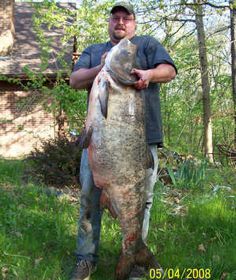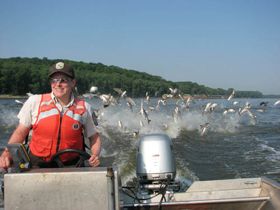Carp Cuisine
Air Date: Week of April 23, 2010

Big Head Carp can reach up to 100 pounds. (The Department of Natural Resources)
Roughly 600 million invasive Asian Carp have made themselves at home in Midwestern Rivers. As officials struggle to keep them out of the Great Lakes, one local company has a solution. It’s started to ship the carp back to China as food, where they’re considered a delicacy.
Transcript
CURWOOD: The 40th anniversary of Earth Day put the spotlight back on efforts to tackle big environmental problems. Many of today’s challenges are more widespread than those we faced 40 years ago. But budgets are tight as well—so here’s a possible solution for one pernicious problem that could end up making money.
[SOUND OF FISH SPLASHING SHALLOW WATER]
YOUNG: That might sound like rain. But it’s actually fish—hundreds of invasive Asian carp launching themselves through the air along the Mississippi river. The leaping fish have injured boaters—but that the least of the problem. The carp can weigh up to 100 pounds; they crowd out native species and they’re spreading north, threatening the Great Lakes.
Now an Illinois company, Big River Fish Corporation, has an idea to scale back the problem—send them back where they came from. The company just shipped its first load of 40 thousand pounds of Asian carp to China. Big River Fish marketing director Ross Harono starts at the beginning of this fish tale.

Silver carp, one of 11 species of invasive Asian Carp, jump out of the water when disturbed by boat motors. (Courtesy of the Wisconsin Department of Natural Resources)
YOUNG: So we brought them to the U.S. on purpose?
HARONO: Yes, they were brought in on purpose. They were basically used to clean up the ponds—they eat algae, they’re basically bottom-feeders, so they’re able to help keep the large fish farm ponds clean.
YOUNG: Now, why is the Asian carp such a problem? We have lots of animals that get introduced—why is this one a problem?
HARONO: Well, the problem you have is that they grow ten percent a year in terms of their mass. So that six years ago when I first looked into this problem there were 55 million pounds of Asian carp in the Illinois River basin—now there’s about 100 million pounds because there’s been no natural enemies for these fish, no method of harvesting them, and there has been no, at least domestic, market for these fish.
YOUNG: And I guess that’s what you with Big River Fish Corporation are trying to solve—you want to create that market, right?
HARONO: Absolutely. Asian carp is viewed as a delicacy in Asia. The bones don’t create a problem because we’re used to eating with chopsticks and we spit the bones out. It’s just sort of an educated mouth and tongue in how to eat these fish. And they’re very tasty, so that there is a tremendous demand for this fish in Asia.

Fishermen use nets to catch Asian Carp in Midwestern Rivers. (Courtesy of Big River Fish Corp)
HARONO: That’s part of the marketing strategy is that we’re marketing it as a natural fish grown wild in the Mississippi River and Illinois River that jumps out it has so much energy, so when you eat it you’ll get some of that energy also.
YOUNG: Tell me about the fish because we have such an, I guess, cultural bias against eating carp here in the States—not many people eat carp here.
HARONO: Not many people eat a lot of the bottom-feeders because it’s viewed as fish that’s for the lower class, the poor, and there’s a cultural stigma against eating these fish.
One of the problems we have with these fish—once again there’s a lot of bones—they have these y-bones, which float on the side, 64 of them. So even though you cut a filet out, you end up with these small bones in it. But in Asia, once again, this is not a problem.
YOUNG: Well, this is a very different way of going about this problem because I guess traditionally what the authorities have been doing is trying to poison the Asian carp, trying to build these sort of electronic underwater barriers to prevent them from getting into the lakes—all of these things cost a lot of money. You’re kind of turning a problem on its head and saying, hey, instead of spending money on this, we might make money off this?

U.S. distribution of the Bighead Carp (Courtesy of USGS)
YOUNG: So you’re shipping 40 thousand pounds to China, but you’re looking at millions of pound of this fish in the rivers? Can an operation like this make a dent in the problem of the Asian carp?
HARONO: Absolutely. If we pull out 30 million pounds a year, and that’s our goal, we’ll have the carp situation under control in five years.
YOUNG: Ross Harono telling us about ideas for taking a bite out of the Asian carp problem. Thank you very much.
HARONO: You’re quite welcome.
Links
Living on Earth wants to hear from you!
Living on Earth
62 Calef Highway, Suite 212
Lee, NH 03861
Telephone: 617-287-4121
E-mail: comments@loe.org
Newsletter [Click here]
Donate to Living on Earth!
Living on Earth is an independent media program and relies entirely on contributions from listeners and institutions supporting public service. Please donate now to preserve an independent environmental voice.
NewsletterLiving on Earth offers a weekly delivery of the show's rundown to your mailbox. Sign up for our newsletter today!
 Sailors For The Sea: Be the change you want to sea.
Sailors For The Sea: Be the change you want to sea.
 The Grantham Foundation for the Protection of the Environment: Committed to protecting and improving the health of the global environment.
The Grantham Foundation for the Protection of the Environment: Committed to protecting and improving the health of the global environment.
 Contribute to Living on Earth and receive, as our gift to you, an archival print of one of Mark Seth Lender's extraordinary wildlife photographs. Follow the link to see Mark's current collection of photographs.
Contribute to Living on Earth and receive, as our gift to you, an archival print of one of Mark Seth Lender's extraordinary wildlife photographs. Follow the link to see Mark's current collection of photographs.
 Buy a signed copy of Mark Seth Lender's book Smeagull the Seagull & support Living on Earth
Buy a signed copy of Mark Seth Lender's book Smeagull the Seagull & support Living on Earth

